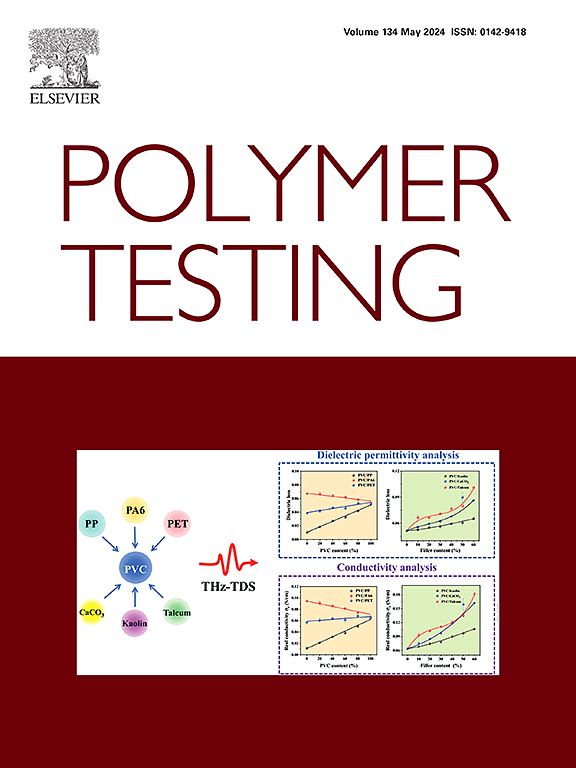Advanced epoxy composites for tribological Applications: Investigating the role of hybrid ceramic and lubricant fillers
IF 5
2区 材料科学
Q1 MATERIALS SCIENCE, CHARACTERIZATION & TESTING
引用次数: 0
Abstract
Epoxy resins are widely employed in structural and industrial applications due to their high strength and chemical resistance, but their poor tribological performance under dynamic loading conditions limits their use in high-friction environments. Enhancing these properties through the use of functional fillers presents a promising approach; however, the combined effects of reinforcing and lubricating agents within epoxy remain underexplored. This study aims to evaluate the tribological and thermal performance of epoxy composites reinforced with silicon carbide (SiC), graphite (Gr), and molybdenum disulfide (MoS2), both individually and in hybrid combinations. Eight composite formulations were prepared via mechanical stirring, ultrasonication, and compression molding, and were subjected to pin-on-disc testing under varying normal loads and sliding speeds. The composites were characterized in terms of coefficient of friction (COF), specific wear rate, and interfacial temperature rise, alongside SEM and EDX analysis of the worn surfaces. Results revealed that SiC improved wear resistance, while Gr and MoS2 reduced COF and surface heating. The ternary composite (EP + SiC + Gr + MoS2) demonstrated the best overall performance, with a 94 % wear reduction and 40 % lower COF compared to pure epoxy. These findings confirm the synergistic benefit of combining reinforcing and lubricating fillers in polymer composites. Future studies should explore long-term performance and applicability under real operating conditions.
用于摩擦学应用的高级环氧复合材料:研究混合陶瓷和润滑剂填料的作用
环氧树脂因其高强度和耐化学性而广泛应用于结构和工业应用,但其在动载荷条件下较差的摩擦学性能限制了其在高摩擦环境中的应用。通过使用功能性填料来增强这些性能是一种很有前途的方法;然而,增强剂和润滑剂在环氧树脂中的联合作用仍未得到充分的研究。本研究旨在评估由碳化硅(SiC)、石墨(Gr)和二硫化钼(MoS2)单独和混合增强的环氧复合材料的摩擦学和热性能。通过机械搅拌、超声和压缩成型制备了8种复合配方,并在不同的法向载荷和滑动速度下进行了销盘试验。通过摩擦系数(COF)、比磨损率和界面温升对复合材料进行了表征,并对磨损表面进行了SEM和EDX分析。结果表明,SiC提高了材料的耐磨性,而Gr和MoS2降低了COF和表面加热。三元复合材料(EP + SiC + Gr + MoS2)表现出最佳的综合性能,与纯环氧树脂相比,其磨损减少了94%,COF降低了40%。这些发现证实了增强和润滑填料在聚合物复合材料中的协同效应。未来的研究应探索在实际操作条件下的长期性能和适用性。
本文章由计算机程序翻译,如有差异,请以英文原文为准。
求助全文
约1分钟内获得全文
求助全文
来源期刊

Polymer Testing
工程技术-材料科学:表征与测试
CiteScore
10.70
自引率
5.90%
发文量
328
审稿时长
44 days
期刊介绍:
Polymer Testing focuses on the testing, analysis and characterization of polymer materials, including both synthetic and natural or biobased polymers. Novel testing methods and the testing of novel polymeric materials in bulk, solution and dispersion is covered. In addition, we welcome the submission of the testing of polymeric materials for a wide range of applications and industrial products as well as nanoscale characterization.
The scope includes but is not limited to the following main topics:
Novel testing methods and Chemical analysis
• mechanical, thermal, electrical, chemical, imaging, spectroscopy, scattering and rheology
Physical properties and behaviour of novel polymer systems
• nanoscale properties, morphology, transport properties
Degradation and recycling of polymeric materials when combined with novel testing or characterization methods
• degradation, biodegradation, ageing and fire retardancy
Modelling and Simulation work will be only considered when it is linked to new or previously published experimental results.
 求助内容:
求助内容: 应助结果提醒方式:
应助结果提醒方式:


